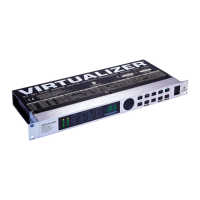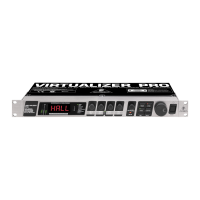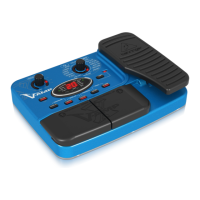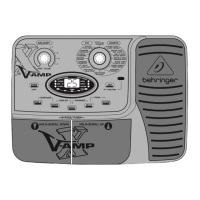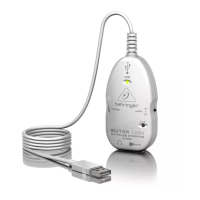PSYCHO
ACOUSTICS
Psycho-acoustic eects
EXCITER: An exciter works with psycho-acoustic principles to add articially
generated overtones to the original signal, thereby increasing its presence and
loudness (the subjective volume impression) without any signicant increase of
the signal level.
ENHANCER: The enhancer works like a dynamic pitch equalizer. Its eectiveness
depends on the associated high frequencies and the intensity of the input signal.
ULTRA BASS: This awesome combination of sub-harmonic processor,
bassexciter, and limiter adds a nal touch to your music production.
STEREO IMAGER: This eect is used to process stereo main signals. The signal is
rst subdivided into middle and side signal (MS Matrix). Both parts can then be
amplied when desired and placed on the stereo image.
ULTRA WIDE: This eect is suitable to pep up speaker systems with an especially
broad stereo image.
BINAURALIZER: The binauralizer also extends the stereo image. Additionally,
itcompensates for inter-channel cross talk of both speakers (left loudspeaker on
right ear and vice versa).
Parameter Function
Gain Gain correction
Frequency Cut-o frequency of the side chain high pass lter
1
(Exciter)
Filter Q
Resonance of the high pass lter (emphasizes cut-o frequency
for Exciter)
Timbre Ratio of straight and unstraight harmonics (Exciter)
Harmonics Kick
Activates an amplication of harmonics dependent on the input
level (Exciter)
Mix Controls amount of harmonics (Exciter)
Bass Gain Degree of the bass enhancer
Sub-bass Frequency Cut-o frequency of the sub-bass low pass lter (Ultra Bass)
Sub-bass Level Degree of sub-harmonics
Harmonics Degree of synthetic harmonics (Exciter)
Harmonics Density Density of harmonics (Ultra Bass)
Bass Gain Degree of original bass signal (Ultra Bass)
Spread
Controls the inuence on the stereo signal (Stereo Imager) /
degree of stereo expansion (Ultra Wide)
Spread Mode Selects between two dierent spread variations (Stereo Imager)
MS Balance Ratio of middle and side signal (Stereo Imager)
Stereo Balance Balance of stereo signal (Stereo Imager)
Mono Balance Balance of mono signal (Stereo Imager)
Center
Amount of center impression in the stereo signal
(Ultra Wide / Binauralizer)
Xover Frequency Frequency of the crossover lter for the center signal (Ultra Wide)
Space Degree of stereo wideness (Binauralizer)
Mode Selects between headphones and speaker operation (Binauralizer)
Speaker Distance Run time / speaker distance (Binauralizer)
Speaker Compensation Degree of crosstalk compensation (Binauralizer)
High Frequency Split frequency of the crossover lter for the side chain (Enhancer)
High Gain Amount of added high frequencies (Enhancer)
Bass Width Character of added bass frequencies (Enhancer)
Mid Q Bandwidth of added mid frequencies (Enhancer)
Mid Gain Amount of added mid frequencies (Enhancer)
Harmon. Freq. Frequency of added bass harmonics (Ultra Bass)
Harmon. Level Amount of added bass frequencies (Ultra Bass)
Tab. 2.5: Functioning of the psycho-acoustic eects’ parameters
1 High pass filter, which allows frequencies above a specified cut-off frequency to pass and damps the
frequencies lying below it.
2.6
FILTER/EQ
Filter/EQ eects
FILTER: Filters, in general, inuence the frequency response of a signal. A low
pass lter allows low frequencies to pass and suppresses high frequencies,
whilea high pass lter allows high frequencies to pass and suppresses
lowfrequencies.
PARAMETRIC EQ: The parametric equalizer is the most highly-developed
form of equalization. You can control the three parameters which dene the
so-called gauss equalizer curve: bandwidth, frequency and amplitude boosting
or lowering.
GRAPHIC EQ: Eight lter bands are arranged next to each other for this graphic
equalizer. In contrast to the parametric equalizer, frequency and bandwidth are
pre-determined here.
Parameter Function
Base Frequency Cut-o frequency
Depth Degree of inuence
Resonance Resonance of the lter
Type Operating mode of the lter
Attack Response time of the envelope follower
Release Release time of the envelope follower
Speed Speed of the LFO
Wave Sets the curve of the LFO
Gain 1/2 Boost/cut (param. EQ)
Freq. 1/2 Mid frequency (param. EQ)
Q 1/2 Q factor (param. EQ)
200 Hz Boost/cut at 200 Hz (graph. EQ)
400 Hz Boost/cut at 400 Hz (graph. EQ)
800 Hz Boost/cut at 800 Hz (graph. EQ)
1.6 kHz Boost/cut at 1.6 kHz (graph. EQ)
3.2 kHz Boost/cut at 3.2 kHz (graph. EQ)
6.4 kHz Boost/cut at 6.4 kHz (graph. EQ)
Mix Gain correction (Auto Filter / LFO Filter)
Gain
Output gain of the lter block
(parametric / graphic EQ)
Tab. 2.6: Functioning of the lter/EQ eects’ parameters
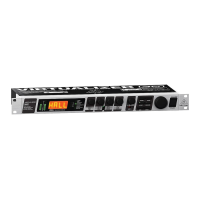
